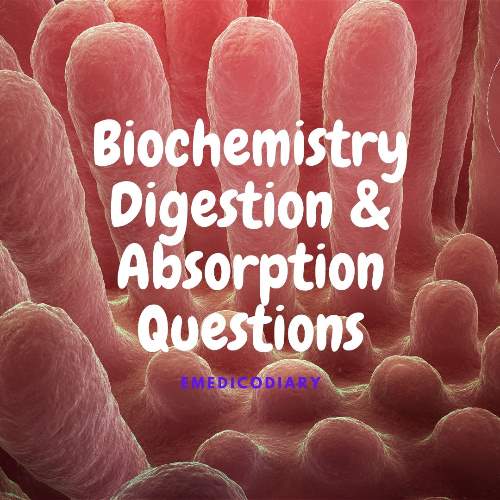Digestion and Absorption
Short questions
- Name the CHO splitting enzyme
- Name the proteolytic enzymes.
- Mention the synthesis and function of bile
- What do you mean by entering the hepatic circulation of bile?
- Enumerate the digestive enzymes present in Mention their substrate and product with a ph range of action.
- Name the dietary lipids. How lipids are digested and absorbed.
- Name the bile acid and bile salts.
- Justify bile as a digestive juice.
- What is the enzyme of CHO digestion?
- How glucose is absorbed
- Enumerate the common digestive juices with their normal pH. Sources and volume
- How free energy is related to entropy and enthalpy.
- Digestive enzymes present in GIT.
Broad questions
- How are end products of fat digestion are absorbed from the intestine, How neutral fat is digested in GIT.
- Name the amyl lyrics enzyme of GIT.
- Digestion and absorption of CHO.
- What are micelles? Movement of the alimentary tract.
- How bile is helps in fat digestion and absorption?
- What is intrahepatic circulation?
- How HCOC3 of pancreatic juices is formed.
- Daily secretion PH and composition. Of i) saliva ii) gastric juice iii) pancreatic juices.
- How end product of starch and lactose digestion are absorbed?
- Short note:
- lactose intolerance
- structure
11. lipolysis enzyme in GIT
12.How dietary starch digested in GIT.
CHO Metabolism
Broad questions
- Catabolic pathways of glucose metabolism
- Describe glycolysis.
- Describe the TCA cycle with a diagram.
- Calculate total ATP in the TCA cycle and aerobic glycolysis.
- Describe HMP shunt with importance.
- Importance of HMP shunt in liver and RBC.
- Sources and fates of pyruvic acid in the body.
- Sources and fates of acetylcholine
- Difference between aerobic and anaerobic and anaerobic glycolysis.
- Define gluconeogenesis? What is the substrate for gluconeogenesis? Mention it’s the importance of it.
- How many ATP are produced in aerobic and anaerobic glycolysis?
- Glucose and amino acid absorption. Importance of anaerobic glycolysis.
- The TCA cycle is a common metabolic pathway.
- Name the metabolic process that occurs in mitochondria
- Give an overview of metabolism.
- Mention the irreversible stage of glycolysis
- How the TCA cycle is related to the urea cycle. 10 molecules of ATP are 150rm per term of the citric acid cycle. Explain
- Why the TCA cycle is called amphibole pathways
- Define the respiratory chain. Mention the components of the respiratory chain and how ATP is produced.
- Short note: a) core cycle b) gluconeogenesis c) G6PD d) porphyria e) glycogen storages disease.
- Metabolic pathways of carbohydrates metabolism. Importance of anaerobic glycolysis
- Metabolic pathways that take place in mitochondria
- Describe the mechanism of oxidative phosphorylation. What are the reactive oxygen radicals?
- How ATP is formed in mitochondria.
- Enumerate the high energy compound.
- How glucose is synthesized from pyruvate
Protein metabolism
- Short note: (a) transamination (b) oxidative deamination (c) fate of amino acid (d) metabolism disposal of ammonia in the body (e) NH4 intoxication f) sources of NH3
- Describe the urea cycle including location. The fate of urea. Raw material and the importance of the urea cycle.
- Draw with important: Krebs urea cycle
- Importance of transaminase. What are the protein splitting enzyme in GIT
- What are protein turnovers and amino acid pool
- Metabolism of ammonia
Lipids metabolism
Broad questions
- Describe B- oxidation of F.A
- Importance of cholesterol. Pentose and hexose.
- Calculate ATP generation by complete oxidation of palmitic acid.
- How ketone bodies are formed
- Sources and fates of ketone bodies.
- Why 3fatty acid are cardioprotective
- How ketone bodies eliminate from the body
- Synthesis of cholesterol
- Metabolism of a) LDL b) HDL c) chylomicrons
- Why ketoacidosis occurs in starvation?
- Write down the structure and metabolites fate of chylomicrons
- How ketone bodies are synthesized classifies lipids with examples. How TG is digested in GIT
Short questions
- Name the ketone bodies
- The fate of chylomicrons and structures
- How fate burns in the fluid
- Formation of chylomicrons
- What are the dietary lipids?
- What is fatty liver?
- Calculate the energy production from 18-carbon fatty acids metabolism
- Define the lipids profile. Give their normal range in SI units mention the importance of HDL cholesterol and LDL cholesterol
- Describe ketogenesis
- Give salient features of cholesterol metabolism
- How ketone bodies give energy during starvation
- What is lipoprotein? What is its function?
- Define and classify porphyria, how harem is synthesized.
- How ketone bodies give energy during starvation.
- Draw and label the structure of lipoprotein.
- What are the fates of cholesterol
- Give some conditions characterized by excessive production of ketone bodies. Explain the derangement and consequences of ketosis.
- What is metabolic syndrome?
- The end product of lipids digestion. How these absorbed
Also read: Biochemistry Questions & Answers
Also read: Question Collection

Comments (0)